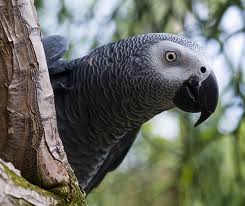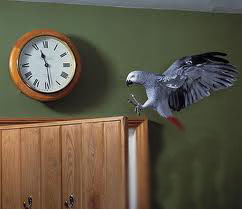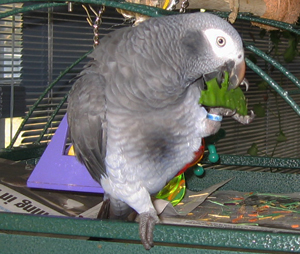
PARROT RESCUE
AFRICAN GREY
The African Grey is one of the most popular pet parrots in the uk. These are good talkers and can be easy to tame.

-
- The African Grey as you expect is grey all over and had a lighter shaded face. The underside of their tails is red in colour.
Can be an excellent talker and can even put basic sentances together
| HOME |
|---|
| SPECIES |
| REHOMING |
| LOST |
| FOUND |
| LINKS |
| FOR SALE |
| EMERGENCY |
| HELP |


DIET & NUTRITION
A variety of food is essential for providing the best possible care for your parrot.
A pellet based diet is the best thing for your parrot but this must be supplimented with foods like:
Carrots, Broccoli (calcium),Peppers, Celery, Cucumbers and Leaf lettuce (not iceburg)
Melons, Kiwi, Grapes, Oranges and Berries
No No Foods
Alcohol, Coffee and Caffein, Chocolate, Avocado, Mushrooms, Onions, Rhubarb and High Fat foods
HEALTH AND BEHAVOIR
|
CAGE
African Grey Parrots are very sociable and require a lot of attention and interaction. Thus it is important to make sure that their cage and environment is more than adequate for their housing needs.
The cage is a safe retreat or haven for your African Grey Parrot. This is where the bird feels safe and secure, no different than what you feel when you walk into the door of your home. There is food to eat, water to drink and best of all toys to play with!
A suitable cage for an African Grey Parrot is at least 2 feet deep by 3 feet wide by 4 feet high (61 x 91 x 122 cm) and has a playpen top with a tray. African Grey Parrots are very active and need a lot of "out" time. It's important to make sure that there are toys both inside the cage and outside in the playpen area to keep your African Grey busy.
It is best to get a cage that has horizontal side bars to help these nimble climbers get their exercise as they climb up and down the sides. A cage with too few horizontal bars has shown to contribute to a lack of motivation and curiosity. You should avoid a round cage as converging bars can trap toes or feet. A square cage also provides more room for your African Grey Parrot.
The cage you select is going to be home to your African Grey Parrot for a long time, so don't skimp – obviously you want something that is going to last so make sure you check it thoroughly. When selecting your African Grey cage keep in mind the following:
-
Quality of the cage –The bars of the cage should be too thick for the African Grey to bend and where the bars join should be smooth. No sharp edges, flaky finish or easy to disassemble. We're dealing with Einstein's here!
-
Material of the cage – the cage should be made from noncorrosive metal. Powder-coated cages typically stand up best to the test of the African Grey Parrot's beak and are usually very safe. Other acceptable metals include steel, brass or chrome. Zinc, which is toxic to birds, are in shiny welded wire and hardware cloth and cages that have these substances should not be considered for your African Grey Parrot.
-
Bars of the cage – There should be no openings or spacing between the bars large enough for your African Grey Parrot to put their head through or small enough for them to catch their toes. Typically, a good rule of thumb is the bars should be spaced about ¾ - 1 inch apart.
-
Perches of the cage – the perches that come with the cage might need to be replaced. African Grey Parrots love to grip the perch and flap their wings so make sure that you have a variety of easily gripped sized perches available for their use. For them to be able to grip the perch the opposing long toes need to extend at the least a little more than halfway around.
-
Trays and Grates – Make sure the trays and grates are removable so they are easily cleanable.
-
Dishes – Stainless steel or ceramic bowls are easier to keep clean and last longer than aluminum dishes. If the cage comes with aluminum dishes, you should replace them.
The cage should be kept clean by wiping it down with detergent and water or a bird safe disinfectant solution. Newspaper seems to be the safest bedding as organic bedding can cause illness and death if ingested, also the dust associated with them can be harmful.
The location of the African Grey cage in your home is very important. African Grey Parrots are flock members and like to be where the action is. They need the human interaction and their curiosity to know what is going on makes the place where the cage is essential to their health and happiness. Most African Greys' cages seem to live in dining and living rooms, but remember not to expose the cage on all sides so they will still have a secure feeling when in their home.
TOYS
African Grey Parrots love toys! Toys they can chew on, shred, untie knots, take apart, puzzles, wiffle balls, bells and toys they can hang onto. African Grey Parrots are highly intelligent and need toys to keep them busy. They get bored easily and need stimulation. It is amusing and downright entertaining when you get to see an African Grey Parrot in the midst of playing. African Greys play hard and can be having such a good time that they sometimes forget to hold on and fall from their perch.
Choosing a Safe Toy for Your African Grey
When choosing a toy for your African Grey Parrot, make sure it is sized appropriately. Toys for smaller birds are not strong enough and small parts can become easily detached and swallowed or lodged. Make sure there are no sharp edges and that the materials used are safe for your African Grey Parrot. If he loves bells, make sure they are "safe" – no "jingle bells" and you should replace the clapper with a small stainless steel quick link.
You will soon figure out what type of toy and / or activity your African Grey Parrot prefers. Just watch and learn!
Chewing - Destroying wood is a natural instinct for your African Grey. Provide them with wood, cardboard, rawhide and paper.
Puzzler Toys – some African Grey Parrots like toys where they can move a lever or chew a box to get a treat
Interactive and / or "Noisy" Toys – baby rattles, music boxes, shape interactive toys, wiffle balls, etc.
Rope toys can fray easily so keep an eye on these for loose areas that need trimming and supervise the use of these. There have been instances where African Grey Parrots have gotten their beaks and toes caught in frayed objects.

Make Your Own African Grey Toys
Use your ingenuity and create toys out of normal household items to help keep your African Grey Parrot busy.
- Wad up bits of newspaper
- Cut up pieces of cardboard that they can hold in their "hands" and demolish
- A ballpoint pen with the ink barrel removed. Make sure it is all plastic and no metal.
- Plastic straws
- Wrap a nut or treat into a piece of paper
- Wine bottle corks – real ones only!
- Plastic bottle caps with any inserts removed
- Large buttons
- Large stainless steel bolts and washers – make sure they're clean
- Unwaxed paper cups
- Popsicle and other wooden sticks
- Cardboard rolls (unscented)
- Wooden spools and clothes pins with wires removed

Make sure you keep salvageable pieces and parts of store-bought toys that have been destroyed during playtime. Place in a "toy box", a cardboard box works great or purchase some thick natural rawhide and string the beads, blocks, etc. to create a "new" toy for your African Grey Parrot.
Change and rotate the toys every two weeks or so to help keep your African Grey Parrot active and interested. When introducing a new toy, do it slowly. If introduced too quickly, the African Grey Parrot will tend to shy away and very possibly never play with it. If the toy has never been in their cage and / or play top area, make sure they see you playing with it before attaching. Their natural curiosity and wanting to see everything and know all that's happening will encourage them to come check out the new toy with you.
Toys help keep our African Grey Parrots happy, healthy and curious. Let's hear it for toys!